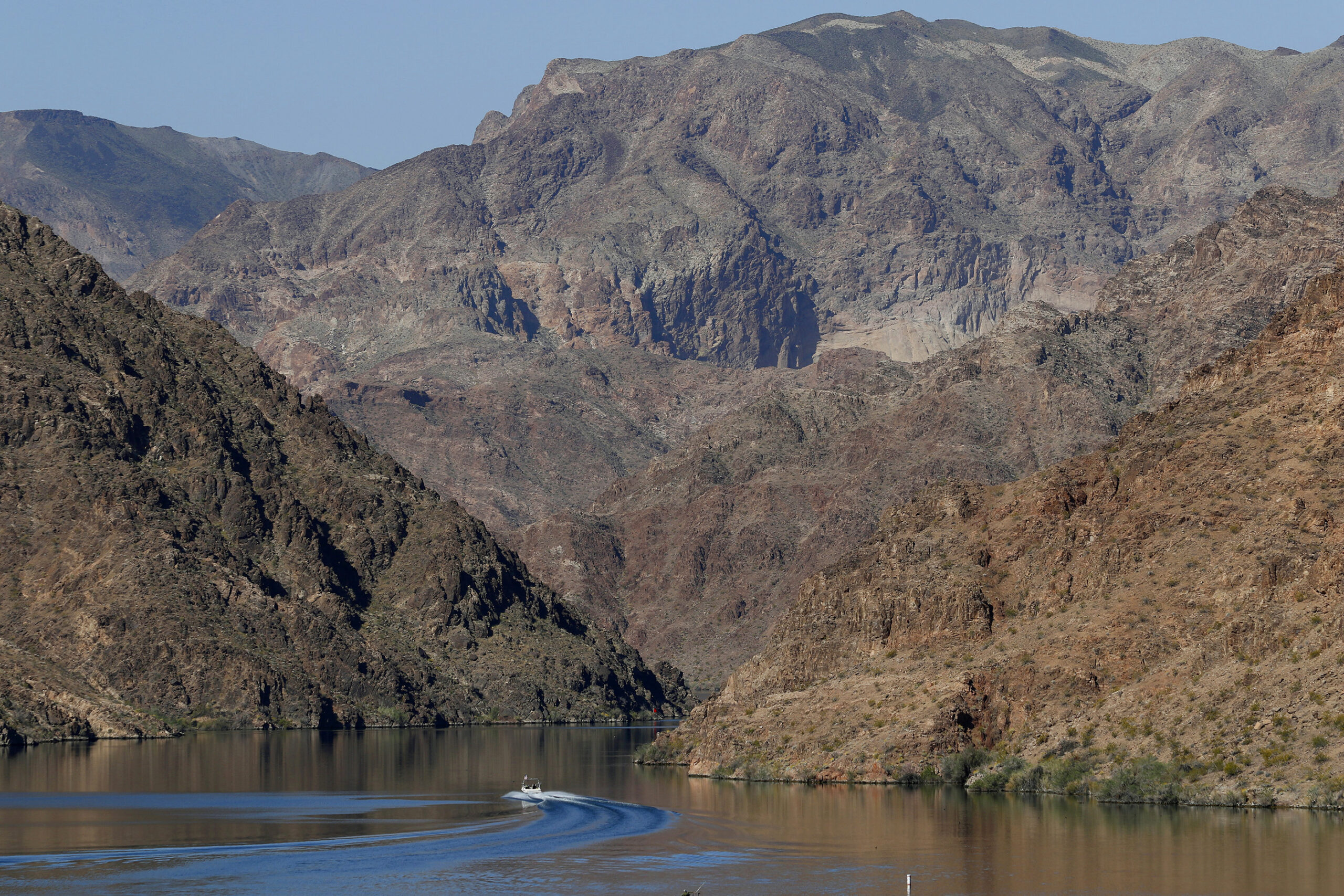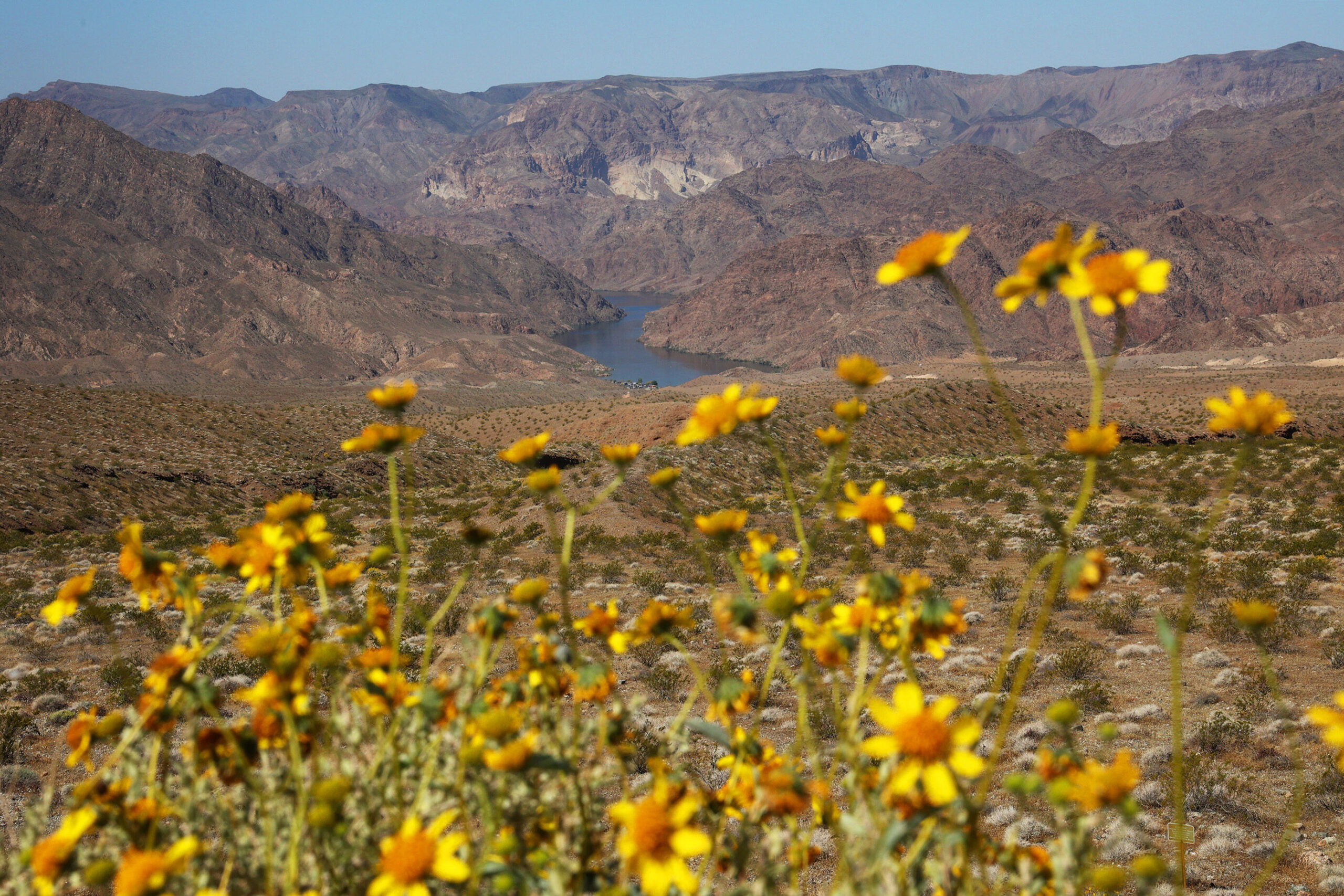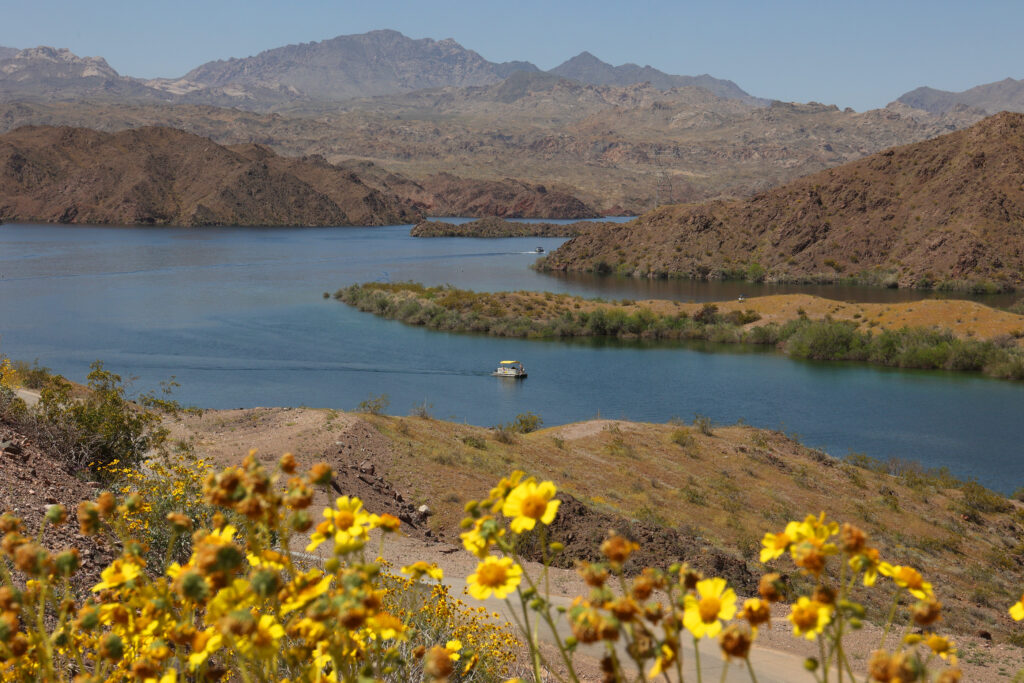Federal officials lay out options for Colorado River cuts if no consensus is reached

Earlier this week, federal water officials released the draft of a much-awaited document outlining potential major short-term cuts to stabilize a Colorado River shrinking due to overuse and drought — unless the seven states that rely on the watershed come up with an alternative.
The last part is key.
Officials made it clear that they still wanted the states to reach a consensus on what painful cuts might look like as any action that is taken by the federal government faces a risk of litigation.
Speaking in front of Lake Mead, with its prominent bathtub ring — one of the most apparent illustrations of the Colorado River shortage — Tommy Beaudreau, deputy secretary of the Department of Interior, said the choices federal water officials laid out “provide room for additional work and solutions.”
The document, he said, “is intended to drive those conversations and negotiations forward.”
The announcement served as a step in an ongoing environmental impact study, led by the U.S. Bureau of Reclamation, to analyze the cuts needed to stabilize the Colorado River’s reservoirs, which serve about 40 million people across the West and have hit record lows in recent years.
The Colorado River and its tributaries form a watershed that spans a massive geography, which includes seven U.S. states, 30 Native American tribes and Mexico. The river supports millions of acres of agricultural land, countless ecosystems, aquatic species, recreation and many of the West’s largest cities, including Las Vegas, Los Angeles, Phoenix, Salt Lake City and Denver.
Southern Nevada receives about 90 percent of its water directly from the Colorado River. All of the states below Lake Mead — Arizona, California and Nevada — comprise the Lower Colorado River Basin and face the possibility of major cuts. In recent years, the Southern Nevada Water Authority has taken proactive steps to offset future cuts with aggressive conservation measures, including the removal of decorative water-guzzling turf and limiting the size of residential pools.
The water authority is still conducting a detailed analysis of the nearly 500-page draft document, authority spokesman Bronson Mack said. But conversations among the states continue.
On Friday, John Entsminger, the head of the water authority, met with counterparts in Arizona and California. In a statement, he called the draft “the next step in the process to find workable solutions to protect water supplies for 40 million Americans and more than a trillion dollars in economic activity.”
The document released Tuesday is a draft of what is known as a Supplemental Environmental Impact Statement, or an SEIS. It amends the current set of guidelines that govern shortages on the river.
As the Western U.S. experienced its worst drought in 1,200 years, it became clear that the existing shortage guidelines, finalized in 2007, were not sufficient to keep the river’s largest reservoir, Lake Mead, from crashing so low it would threaten water deliveries across the West.
Federal water officials launched the SEIS process last year after the seven states tried but failed to reach a consensus over how the painful cuts to the Colorado River should be allocated within a framework of law, known as the Law of the River, that gives California a priority to its Colorado River share over Arizona’s major diversion, a 336-mile canal called the Central Arizona Project.
Eventually, by January, six of the seven states had reached a consensus framework, but without California, the largest user of the river and a meaningful player in making any sizable cutbacks.
The draft SEIS outlines three approaches that the federal government could take:
- The do-nothing approach: Federal operations would implement the existing operating agreements for the Colorado River reservoirs, which would risk the possibility of one or both major reservoirs — Lake Mead and Lake Powell — declining so low they would effectively become inoperable in future years if dry conditions continue.
- Rely on the water rights system: Follow what is known as the priority system outlined in the Law of the River, a compilation of the many compacts, settlements, decrees and treaty documents pertaining to the Colorado River. In general, this system often gives priority to those who have the oldest or “senior” rights, including agricultural districts and tribal nations. This more closely aligned the proposal that California had advocated for.
- Apportion additional cuts evenly: The other action alternative outlined by federal water managers calls for building on existing agreements, which reflect priority, and applying cuts on a proportional basis by assigning an across-the-board cut of up to 15.6 percent. The cuts in this scenario would more closely align to the cuts outlined in the six-state plan and backed by Arizona, putting a larger burden of cuts on California.
But federal officials were clear: This draft document is not the last word. Notably, federal officials did not endorse a preferred option, instead framing the actions as “tools” they could implement.
“It was interesting that they did not do what they said they were going to do and offer a federal [preferred] option,” said John Fleck, a University of New Mexico professor who focuses on the Colorado River and water governance. “They simply offered a federal-lite version of the six-state proposal and the California proposal, and a positive ‘power of collaboration’ argument.”
At a press conference Tuesday, negotiators for California and Arizona signaled willingness to reach a consensus deal and avoid either option, both of which come with risks for each state.


Between two bookend scenarios, a possible deal?
J.B. Hamby, the chair of the Colorado River Board of California and on the board of the Imperial Irrigation District, which holds the single largest entitlement to the Colorado River, said “it is our hope and our fervent desire that the tools laid out in the [document] never have to be used.”
The best way to get there, he said, “is through ongoing work with collaborative processes.” He said that the ideal situation would be to develop a seven-state consensus in the coming months, if not weeks.
During the press conference Tuesday, Tom Buschatzke, who directs the Arizona Department of Water Resources, also echoed the continued need for states to come up with a negotiated deal, noting that officials from Arizona, California and Nevada have been discussing paths forward.
Buschatzke said the goal is to avoid litigation.
“So we have to avoid that outcome,” Buschatzke said, arguing that it could take decades to settle any lawsuit, time that negotiators do not have to reach major agreements on cutbacks. “Once litigation occurs, if it does, it's going to be very difficult to negotiate something moving forward.”
Setting up bookend alternatives could give the states more boundaries by which to negotiate a path forward that balances the priority system and equity, water experts said.
“What they are trying to do is set up the worst-case scenario for California” by showing what could be done if officials deviate from a strict application of priority, said Elizabeth Koebele, a UNR professor who focuses on water policy and has followed the negotiations over the cuts.
Each state has internal dynamics to sort through
Much of the rhetoric around the Colorado River negotiations has focused on the long-held and ongoing tensions between California and Arizona’s share of water on the river.
While California has priority rights over water that flows through the Central Arizona Project — water that is delivered to cities, tribal nations, agricultural districts and industrial users — each state has internal dynamics that will influence what happens next.
What priority looks like within — and between — the three states is extremely complicated.
For instance, although California is often seen as the senior user on the river, the Metropolitan Water District — the major municipal water purveyor for Southern California — has rights that have less priority relative to other water users and could be cut off in either of the alternatives.
In a statement, the water agency’s general manager said neither alternative is ideal.
“Both include significant supply cuts that would hurt Metropolitan and our partners across the Basin,” General Manager Adel Hagekhalil said. “There is a better way to manage the river.”
Arizona also faces complicated internal dynamics when it comes to what curtailment by priority would actually look like. Although Arizona supported an equitable approach and is often seen as junior to California, several Arizona water users have high-priority water rights to the Colorado River. During the Tuesday press conference, Buschatzke said that the several water users in Arizona, including Colorado River Indian Tribes and farmers in the Yuma area, wrote letters urging officials to respect the priority system.
Last week, federal water officials began a 45-day comment period on the SEIS as talks continue. A final version of the document will be released after the comment period ends.
“Optimistically, the next 45 days look like meeting some middle ground between the priority approach and the equity-based approach,” said Rhett Larson, law professor at Arizona State University. "It's going to require a fair amount of give and take, including intrastate negotiations.”

Still searching for a long-term agreement
The two options weighed by federal officials are part of a larger dialogue over the long-term management of the river. The cuts are meant to stabilize Colorado River reservoirs until 2026.
The 2007 guidelines for operating the river are set to expire in 2026, and officials must renegotiate a new set of rules in the coming years.
Since last year, drought conditions in the Colorado River Basin have improved with large storms increasing the snowpack — the primary source of the Colorado River — to well-above average.
As the snow melts this summer, reservoirs could start recovering from record lows. But one year of low runoff after 2023 could quickly put the river back into a dire situation, especially given the existing deficit. In addition, many water experts believe significant cuts are still needed to ensure the basin is able to rebuild storage in the reservoirs, rather than continuing to overuse water.
“The hydrology this year has been nothing short of amazing and I think it’s up to us to ensure that we don’t squander it,” said Estevan López, the Colorado River negotiator for New Mexico. “We have an opportunity here to rebuild supplies that were kind of loaned to the system, if you will, under the emergency drought actions that were taken over the course of the last year.”
Even with one good year of snowpack, the Colorado River faces significant challenges — with more rights to water than there is water to go around. On top of these structural problems and continued overuse, a changing climate and warmer temperatures are making the region more arid, contributing to less runoff in recent decades and more uncertainty about water supply.
As negotiators focus on long-term river management and renegotiating the 2007 rules, they must also address inequities embedded in the river’s foundational documents, which excluded tribal governments and gave little consideration to the river’s ecosystems, which have been damaged by overuse.
At the press conference Tuesday, Rosa Long, vice chair of the Cocopah Indian Tribe and chair of the Ten Tribes Partnership, urged all states to focus on conservation measures.
“In closing, let us commit to continuing our collaboration and to work together in the spirit of mutual respect and understanding,” Long said in her remarks Tuesday. “By doing so we can ensure that the Colorado River remains a vital and thriving resource for generations to come.”
